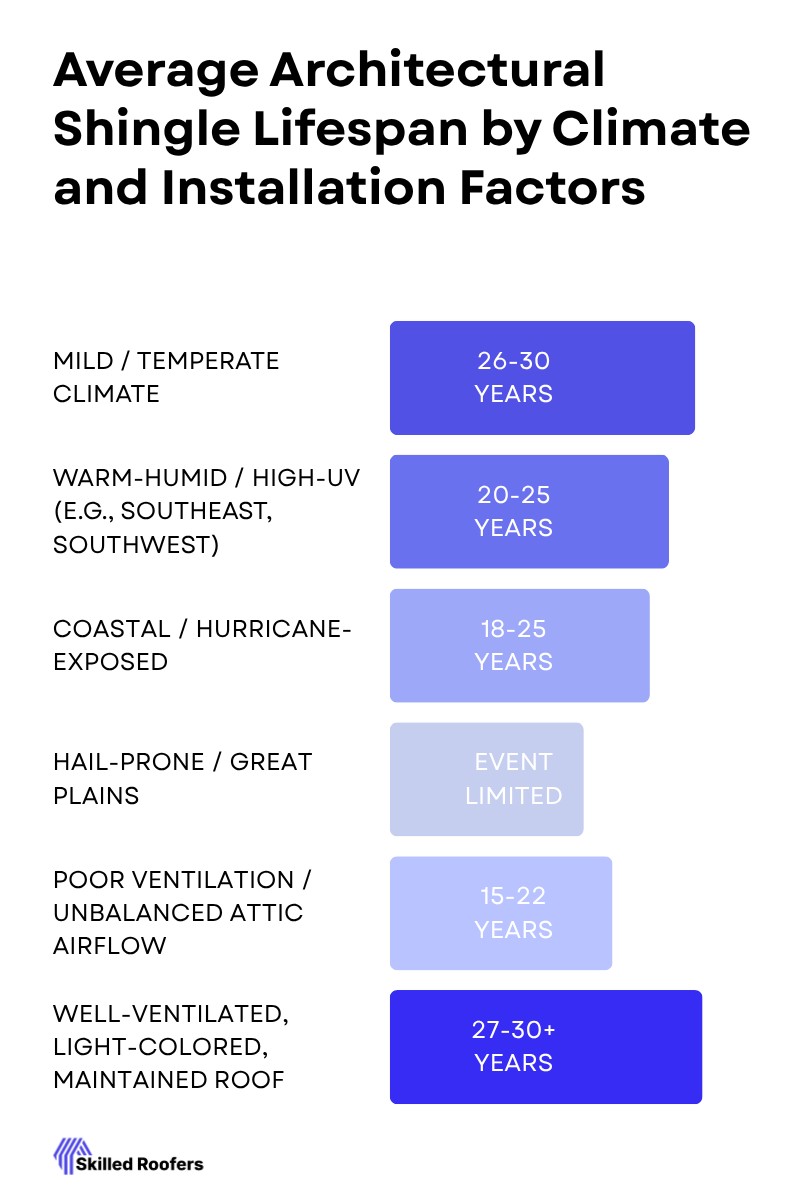
Most homeowners are told that architectural shingles should last thirty years. After extensive research into manufacturer data, independent testing, and national field studies, we’ve found that number is rarely accurate. The term “30-year shingle” refers to a warranty class, not a guaranteed lifespan. In practice, these roofs perform anywhere from the low-20s to about thirty years—and the difference almost always comes down to installation quality, climate stress, and attic ventilation.
What We Found When Comparing Research
When we began comparing published lifespan data, one thing became clear: roofs built with identical shingles age very differently depending on region. In coastal and southern climates, the same brand labeled for 30 years often needs replacement around year 20 or 22. In more temperate zones—the Midwest or Northeast—many reach 27 to 30 years before significant aging appears.
Our findings align with the Institute for Business & Home Safety (IBHS) study, Performance of Asphalt Shingle Roofs in the Real World, which examined roof performance during Hurricanes Gustav and Ike. Their field data confirms that prolonged exposure to UV, wind, and temperature swings steadily weakens adhesion strength. The shingles don’t suddenly fail—they gradually lose resistance to wind and impact.
The InterNACHI life-expectancy chart supports this trend, placing architectural asphalt shingles at roughly 30 years under standard conditions. The key phrase is standard conditions. In regions with poor attic ventilation or extreme heat, real-world lifespans drop closer to 15–20 years.

Why “30 Years” Rarely Means 30 Years
Roofing ratings come from controlled lab tests—steady temperature, perfect sealing, and uniform wind exposure. Real roofs live through daily expansion, contraction, and moisture cycles that no laboratory replicates. Once shingles pass the 10-year mark, sealant bonds begin to weaken, and research from IBHS and Applied Research Associates shows a clear decline in wind resistance from that point onward.
Post-storm inspections summarized in those studies reveal that after a 60-mph wind event, newer Class H shingles retain strong adhesion, while older ones lift or lose corners even without visible cracking. That drop in holding strength isn’t cosmetic—it’s mechanical aging.
Ventilation also plays a defining role. Attic temperatures in poorly ventilated spaces can exceed 150°F, accelerating oil loss in the asphalt layer and making shingles brittle. Studies based on International Residential Code (IRC) Section R806 ventilation ratios (1:150 to 1:300) show significantly lower heat stress and longer roof service life when air movement is balanced between intake and exhaust.
The Role of Climate
Climate remains the single most decisive factor. In moderate regions with steady temperatures, architectural shingles often reach the upper 20s or full 30-year mark. In high-UV, hurricane, or hail-prone areas, lifespans consistently fall to the lower-20s.
Recent IBHS Florida field modeling now includes “aging factors” in its storm-loss data, validating what the National Severe Storms Laboratory (NOAA/NSSL) has long defined—winds above 50–60 mph are “damaging,” and roofs older than a decade show measurable increases in uplift and creasing at those speeds.
Extending Shingle Lifespan
Our review of building-science and manufacturer data highlights several practices that reliably extend roof life. Proper ventilation and balanced airflow are critical. Roof decks sealed according to IBHS’s FORTIFIED Roof™ guidelines experience far less water intrusion during storms—IBHS testing shows sealed decks can reduce interior water entry by up to 95%. Cooler roof surfaces—either from lighter shingle colors or reflective coatings—run 20–30°F cooler in peak heat, reducing thermal fatigue. The U.S. Department of Energy’s Energy Saver guide on cool roofs confirms that cooler roof surfaces retain flexibility longer and lose fewer granules over time.
The Asphalt Roofing Manufacturers Association (ARMA) provides further data showing that routine cleaning and avoiding pressure washing also helps maintain granule integrity and prolong shingle life.
The Realistic Expectation
So, how long do architectural shingles really last? After reviewing the available data, the most realistic range is 22 to 30 years. With correct installation, proper ventilation, and consistent maintenance, a roof can approach the high-20s. Without them, performance drops into the teens. When we encounter a 25-year-old roof still functioning well in case studies or manufacturer field reports, it’s the result of balanced conditions—not luck.
When Replacement Becomes the Smarter Choice
Age alone shouldn’t determine replacement, but it should trigger inspection. Research shows that early signs—granule loss, curling, or surface cracking—signal reduced protection even if leaks haven’t appeared yet. Roofs near the 20-year mark in storm-exposed regions should be inspected annually. Waiting until leaks form often means hidden deck damage has already begun, and replacement costs rise sharply.
Bottom line
After reviewing decades of field data from IBHS, InterNACHI, ARMA, the Department of Energy, and NOAA, we’ve concluded that the “30-year” rating describes ideal conditions rarely achieved in reality. With informed installation, ventilation, and maintenance, architectural shingles can reach the high-20s, but expecting the full thirty years without degradation is optimistic. The best approach is proactive care, realistic budgeting, and understanding what those numbers truly represent.

